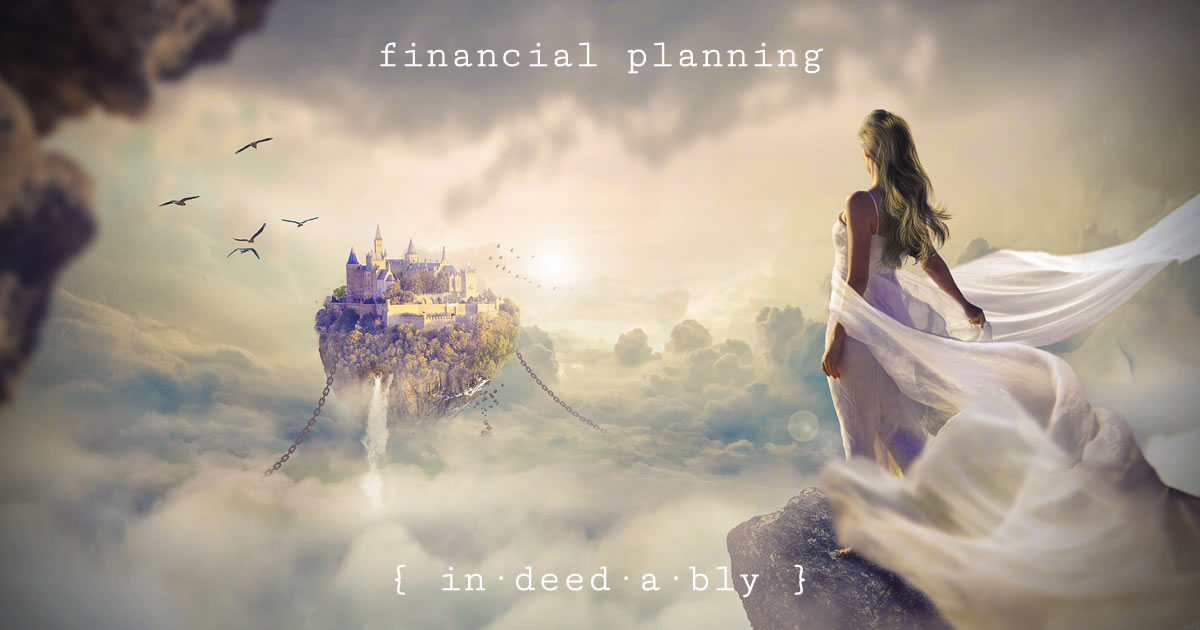We think we know how the story ends.
The brave hero overcomes adversity, conventional wisdom, and self-doubt.
He storms the castle. Slays the dragon. Rescues the damsel in distress.
Together they ride off together into the sunset, to live happily ever after.

Where the story ends. Image credits: creozavr, cyrille, and Clker-Free-Vector-Images,
He smugly reflects on his momentous achievement. He won!
Which is a good thing because he feels burnt out, sore, and is definitely getting too old for this caper.
The happy couple take a victory lap through the village, to provide the locals with a chance to bask in reflected glory of his achievement. It would be fair to say there was a disappointing turnout.
Do they not understand what it took to get to this point? More to the point, does anyone actually care?
One grateful villager presents them with an obligatory farewell cake, then they head for home.
But that is just the end of the beginning. What of the morning after?
Our noble hero wakens tired and cold. It turns out his new lady love snores and hogs the covers! Could this be the reason that nobody had risked their life attempting her rescue before now?
His weary bones protest as he rolls out of bed. Assorted aches and pains tell the tale of advancing age and a lifetime of creature comforts forgone.
Limping into the kitchen, our hero switches on the coffee maker and pours himself a bowl of cereal. Opening the fridge reveals that somebody has used all the milk. Sigh.
The hero slumps down at the kitchen table. It had been clean last night when he went to bed, but now is covered in cake crumbs. On the bench sits a large platter now containing just a tiny sliver of cake, all that remains of the yesterday’s gift.
This was not how he had pictured his dream life of retirement playing out.
Serenaded by the sound of snores echoing from the bedroom, he takes a hit of (black) coffee and skims the news headlines.
A distant land is being terrorised by an evil fire-breathing dragon. Interesting! If he left now he could be there in less than a week…
“This was not how he had pictured his dream life of retirement playing out.”
King of the tech jungle

Enterprise Architect: King of the tech jungle. Image credit: GraphicMama-team.
The apex predator of the technology food chain is the Enterprise Architect.
They know a little bit about everything.
Their superpower is understanding how to meld together all those disparate little things to form a cohesive whole.
These sage greybeards possess a lifetime worth of accumulated wisdom and entertaining war stories. The competent ones have been there, done that, and have the hard-won scars to prove it.
Enterprise Architects operates on a higher plane.
Simple box and line diagrams replace complexity, deadlines, and noise.
Concepts replace code.
Proven principles guide decision-making.
Good Enterprise Architects are successfully able to transform their lofty 30,000 foot world view into a tangible practical reality!
The vision of an Enterprise Architects defines a “desired future state” for an organisation. This sets out where the goal posts are.
It represents the finishing line, the point at which the journey concludes. The emerald castle at the end of the yellow brick road.
An Enterprise Architect’s job is to define the strategy required to attain that desired future state. To call the plays. To identify all the required tools that are needed to get the job done right.
At the other end of that journey lies the “current state”. Where we are today. A baseline. The beginning.
Without clearly understanding both the beginning and the end, it is impossible to put together a viable plan to successfully navigate from one to the other.
A technology journey progresses through a logical sequence of “transition states”. Each has been strategically positioned along the way to chart progress. Milestones.
A good strategy creates a simple, yet brutally effective, triage mechanism: if something will not take you closer to the finishing line, then doing it will lead you astray.
Distraction and noise are constant threats: they clamour for attention, steal time, and divert precious scarce resources away from the successful execution of a strategy.
The enemies of achieving strategic goals are compromise, short-termism, and poor execution.
“if something will not take you closer to the finishing line, then doing it will lead you astray.”
The problem with Financial Planning

Key questions of Financial Planning. Image credit: mohamed_hassan.
In the Personal Finance world, it is the Financial Planner who prepares the plan and the strategy.
These are two related, yet distinctly different things.
A strategy defines the “who”, “what”, and the “why”.
A plan covers the “how” and the “when“.
One of the (many) problems with the traditional approach to Financial Planning is that it focusses only on the plan. The clue is in the name!
To illustrate this problem, consider Elon the rocket scientist.
A plan prepared for Elon in isolation may tell him to accumulate a large collection of nuts and bolts, because one day he will need them.
That is fine as far as it goes, but if Elon’s goal was to build himself a spaceship to fly to Mars, then that plan alone will not get the job done!
The purpose of a plan is to execute a strategy.
If the planner doesn’t understand a client’s goals and objectives, then the plan can only deliver a suboptimal outcome.
The measure of success in a person’s life is more than the sum total of their net worth.
Ebenezer Scrooge was rich yet miserable.
Mother Theresa was penniless yet fulfilled.
When comparing those two, which life would you have rather led?
I suspect most people would choose neither extreme, preferring to combine of aspects of both.
Competent Financial Planners offer good financial advice:
- Maximise your pension pot.
- Tax efficiently package your wages.
- Mitigate your risk through diversification.
- Invest consistently.
- Be patient.
Great Financial Planners recognise that a financial plan exists for a reason: to facilitate the successful execution of a person’s strategy. To make those hopes and dreams a financial reality.
“The purpose of a plan is to execute a strategy.”
“To make those hopes and dreams a financial reality.”
Applying a tech approach to Financial Planning

Getting technical. Image credit: Clker-Free-Vector-Images.
Adopting an Enterprise Architecture approach to the preparation of a Financial Plan results in the creation of an executable strategy for achieving dreams.
Today I will walk you through that process.
First, a disclaimer: There is no personal financial advice being offered here. You are intelligent boys and girls who are more than capable of doing your own research, and drawing your own conclusions. Read on with an open mind and a healthy scepticism!
Second, a health warning: This process requires some serious introspection. If it doesn’t make you uncomfortable then you aren’t taking it seriously. You have been warned!
Third, a license to be honest with yourself: The answers are yours alone.
Nobody is looking.
You don’t have to impress anybody, play to the crowd, or follow the herd.
Just be honest with yourself, then own the outcome!
“You don’t have to impress anybody, play to the crowd, or follow the herd.”
Beginning at the end
Everyone’s journey concludes in death, the only variation being a question of style and timing.
Just like a bad diet, death is impossible to outrun.
Accept this inalienable truth. Make your peace with it. Now move on.
Most people have some idea of how they would like to be living before they expire. What their lives would look like if they were freed of the financial imperative, and could control how they invest their time.
Picture your happy place. The place you escape to when the big bad world gets you down. To seek refuge, relax, regroup, and recover.
Perhaps your dream for the future involves waking up each day to the sound of ocean. Maybe being surrounded by a tribe of noisy energetic grandchildren. Or enjoying endless summer days leisurely pottering in the garden.
The mental picture you are looking for here isn’t one of the fanciful items on your bucket list. It is the safe place you return to between adventures, just like our brave hero in the story. Home.
Think about what that life looks and feels like. Form a high-level view of where it might be located.
This represents the end of your journey. Your goal.
If the mental picture you have painted above closely resembles your current lifestyle and location, then you are already on the right path.
If not, then you have some decisions to make! The road you are currently travelling isn’t leading you towards your goal.

Does the road you are travelling lead to your goal? Image credit: pixel2013.
The straw man

Straw man. Image credit: Clker-Free-Vector-Images.
Now let’s bring that concept to life a little, by reflecting on who is there to share it with you.
- Are you alone?
- Are you sharing your life with someone?
- Is that someone the same person you are sharing your life with today?
It is an inconvenient truth that the majority of relationships fail to go the distance. This isn’t a good thing or a bad thing, it is a simple fact of life.
Don’t believe me? Ask yourself: in your lifetime how many boyfriends, girlfriends, lovers, and partners have you shared a relationship with?
If your number was larger than one then you have proven my point!
Hopefully your current partner features prominently in your happy place. If not, then recognising that at this stage of your planning process is probably a good thing.
Our unlucky-in-love hero was contemplating risking life and limb to escape an unsatisfying home life! Having recognised his relationship didn’t have a long-term future, rather than hiding from that fact, the braver path would have been making the tough decision to either fix things or move on.
Enterprise Architects call what we have created in this step a “straw man”. A starting point, for us to throw bricks at and refine.
The walking skeleton

Walking skeleton. Image credit: anaterate.
Next contemplate what your daily existence in that happy place actually looks like.
The idea of lazily enjoying the sea breeze, while lounging in a hammock suspended between palm trees and sipping an umbrella drink, sounds idyllic in concept.
However living life in a holiday brochure is neither practical nor realistic. For example:
- Where would you shelter when it rains?
- Where did the ice in your drink come from?
- Where do you go to replenish your sunscreen?
Take the time to think through and explore the practical realities of your ideal location.
The less exotic your choice, the easier these questions can be answered. Choosing to remain in your current home, supported by all the existing infrastructure that you already enjoy makes this section conveniently easy!
The more exotic your dream lifestyle, the more challenging answering those questions will be, for example:
- Is owning a car practical on Gozo?
- How do I get my Amazon parcels delivered if I live on a cruise ship?
- Would moving to Tristan da Cunha be far enough away to escape my mother-in-law?
Map out what “a day in the life” would actually look like by working through the list of questions below. This isn’t about ticking off your bucket list items, it is sketching out what your everyday life would look like:
- Where would your food come from? Is there a grocery store nearby? Restaurants? Home delivery? Or would you need to grow your own?
- How would you get around? Is it convenient for public transport? Would you need a car? Where is the nearest commercial airport?
- When loved ones wish to visit, how will they get to you? Where will they stay?
- What are the local health facilities like? Do you have ready access to a GP? How far away is the nearest emergency room? How about treatment for something more serious, like chemotherapy?
- How will you stay fit and active?
- What will you do for intellectual stimulation?
- What do you do for fun and entertainment?
- Will Amazon deliver there?
- Does it have broadband internet? Wifi? Netflix?
- Will it get snowed in during the winter?
- Is it vulnerable to water shortages and bushfires during the summer?
- Who does your daily chores? A nanny? A housekeeper? A gardener? Yourself?
- Is it compatible with your existing obligations: young children, elderly parents, or pets?
- What (if any) social security and state pension arrangements may be available to you there?
- What happens when your fridge needs replacing, or your boiler requires spare parts? Is that resolved by a quick phone call or a visit to the local shopping centre? Or would you need to arrange for things to be imported by sea, with all the lead times and paperwork that entails?
This list of questions isn’t supposed to be exhaustive. It is designed to get you looking beyond the dream and start to exploring the realities beneath.
These questions won’t answer themselves, so no matter how much you may wish it were otherwise, covering your ears and singing “la-la-la” won’t magically make them go away!
If you haven’t been able to arrive at viable answers to these sorts of questions, then you have some further thinking to do. You may need to conduct an honest re-evaluation of how feasible your desired journey’s end actually is.
At the end of this exercise you should have a reasonable idea of what your desired future state lifestyle actually looks like.
The Enterprise Architect would describe this as a “walking skeleton”. Your dream lifestyle has an identifiable shape and structure to it. It is possible to see how it will function in practice.
Proof of concept

Low risk proof of concept. Image credit: MiluCernochova and OpenClipart-Vectors.
Think back through your responses to the “day in the life” list of questions. How many of the things you detailed can you start doing, in some form, today?
If you are honest with yourself the chances are pretty good there will be quite a few.
Common features on many goal lists include things like eating healthier, learning to cook, getting fit, hiking, reading, learning a language or instrument, spending quality time with loved ones, and “being present”.
This begs the obvious question: if not now then when?
If these things are really important to you then you will prioritise them.
Making the required adjustments to how you invest your time has several benefits:
- You will be doing things you want to be doing today. Now! Nobody knows how long they will live, so delaying enjoyment is not without risk.
- It provides an opportunity to try out some of those things you believe you will enjoy.
- Test driving some elements of your desired life, before committing to it, reduces risk.
Enterprise Architects would call this a “Proof of Concept”.
It is a limited risk, limited size, limited scale implementation of what the future product might look like.
Quicker to design and deploy than the final product. Cheaper and easier to modify too.
The success of proof of concept is judged by what is learned.
Success may be confirming something you already believed. Perhaps you really are happier spending more time playing with your kids, and less time vacuuming.
Success may also be dispelling a mistaken belief. Maybe a complete absence of timing and rhythm meant learning an instrument actually made you miserable, despite your childhood dream of playing cello as well as Yo-Yo Ma.
A plan for a plan

Plan for a plan. Image credit: Wiki Commons.
Our walking skeleton provides a reasonably realistic picture of what your dream life looks like.
According to the life expectancy tables, the chances of you living until the ripe old age of 90 or 100 are not unreasonable.
Therefore if you are aged 40 today, then your financial plan needs to map out how you will fund your lifestyle for potentially another 50-60 years!
For the avoidance of doubt, that time horizon remains true regardless of whether you choose to pursue your dream with a vengeance, or have already decided it is all too hard!
The next step is to put some realistic numbers around your goal.
What will it cost to execute your strategy?
How much ongoing funding will it require to sustain it?
Getting established requires some one-off upfront expenditure.
If your dream involved living largely as you do now then you have probably incurred much of this already. This may include things like purchasing housing or vehicles, furnishings, clothing and so on.
Should your dream involve moving further afield, then you will incur relocation costs, as well as the (potentially significant) costs associated with getting established in your new locale.
The amount required to get established will vary considerably with your personal tastes and chosen locale. For example, Ko Samui costs a lot less than Kowloon or Kensington.
A bit of internet research will help you arrive at a realistic ballpark figure for what these upfront costs to become established your desired locale will be.
Recurring day-to-day expenditure must also be calculated. This includes things like food, healthcare, housing costs (maintenance, rent, etc), transportation costs (bus fares, fuel, vehicle repairs, etc), and utilities.
Don’t forget the recurring items many people forget to budget for: gifts, holidays, repairs, replacing worn out furnishings and cars.
The individual items in this second group vary one year to the next, but you can be pretty sure that every year some of them will occur!
Return to the internet and research an approximate annual number for those recurring costs in your chosen locale.
Those two figures are going to be important inputs for formulating the financial plan required to achieve your goal.
Transition state architectures

Milestones along the journey. Image credit: Pixabay.
It is important to remember that you don’t have to do everything all at once.
Nor must you have to wait until the end before enjoying your progress to date.
Enterprise Architects define “transition state architectures”, which are essentially stepping stones along the journey.
It makes sense to adopt a similar approach to your financial plan.
For example you could:
- buy an old fixer-upper house in your dream location today
- rent it out until you are ready to live there yourself
- defer the renovations required until you can afford them
- phase those renovations so that you gain increasing enjoyment over time, without having to afford everything all at once
Revisit your goal and your “day in the life” answers. Group and organise them into logical sequence of dependencies.
Now determine which of those represent significant milestones along your journey.
Until now I have discouraged you from thinking about the items on your bucket list.
This is because we first needed to understand what real life was going to cost.
Now it is time to think about all those amazing places you wish to visit and experiences you dream about of enjoying!
The cost of these things are in addition to the baseline dream lifestyle costs you calculated above.
This makes sense when you think about it, as you have to keep paying your mortgage/rent and utility bills regardless of whether you are at home or away on vacation.
Just as we discussed proof of concepts earlier, in many cases there is no need to wait until you have realised your dream lifestyle before crossing off some of your bucket list items.
The important thing is to establish the sorts of things you want to do, and an approximate plan for when you would like to do them.
These bucket list items form additional milestones along your financial plan, ensuring you enjoy the ride while journeying towards your ultimate goal.
The end of the beginning
Having worked through the steps above in a structured way, you now have a good understanding of your goals and what you are striving to achieve.
You have defined what your desired future state looks like: the day-to-day existence you dream of enjoying, and where that might be enjoyed.
More importantly, you have thought through what is important to you, why you want to lead that existence, and whom you hope to share it with.
You have charted the course for your financial journey to follow, beginning with where you are today to concluding where you have placed the finishing line.
Importantly, you have put together a host of milestones and bucket list items to enjoy and experience along the way.
Only now are you in a position to start your financial planning, to prepare an informed strategy and plan capable of achieving your goals.
References
- The Open Group (2018), ‘TOGAF® Series Guide Set‘, December 2018 Edition



[HCF] 12 December 2018
Thank you for the detailed description.
Very timely.
Helps a lot in doing my homework 😉
{in·deed·a·bly} 12 December 2018 — Post author
Hope you find it helpful HCF, thanks for reading.
Business Cash Flow 1 May 2020
Thanks for sharing this article. I think that financial planning is very important for business. This will surely help us to ensure that we can achieve a good money management and good financial status.
{in·deed·a·bly} 1 May 2020 — Post author
Thanks for reading.